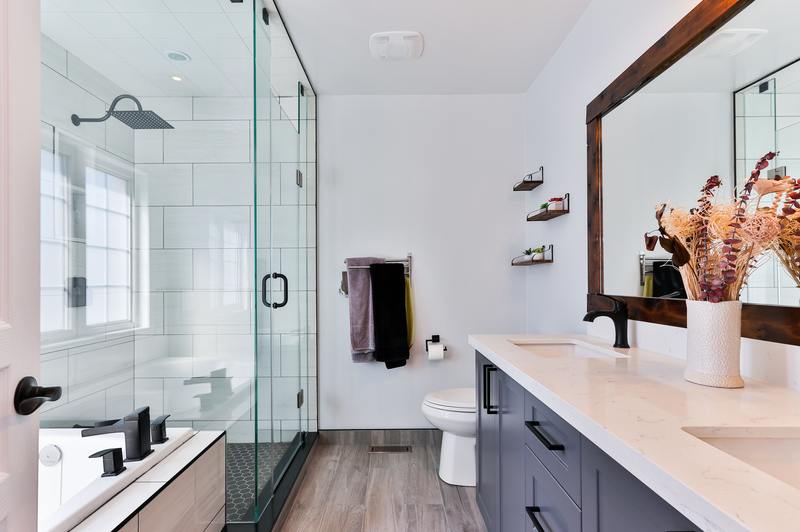Knowing how to paint a bathroom ceiling with mold is a great way to restore the beauty of your shower. Before painting, you must first kill the mold and use a primer on the stained area.
Painting over the mold is not enough. It would be best to take steps to prevent mold from coming back. Continue reading to learn the steps on how to properly paint a bathroom ceiling with mold.

Steps On How To Paint A Moldy Bathroom Ceiling
Painting over mold without killing it and treating the area first is a horrible idea. If you paint over mold, the fungi stay alive, chip the paint, and eventually show up again.
Allowing the mold to survive and thrive behind a coat of paint gives the mold freedom to grow, causing adverse health problems to your family and even devaluing your home. For more information, check out this helpful article on how much does mold devalue a home.
With that said, here is a list of steps you should follow so that you can paint over the moldy area and prevent the fungus from coming back.
Step #1. Clean the mold out
Cleaning the mold out is essential for repainting your bathroom ceiling. Luckily, you can get rid of mold by using household products.
You can make a solution of one part bleach and one part water and pour it into a spray bottle. Spray the moldy area with the solution and let it stay for a few minutes. Bleach has a very strong odor so it would be best to open the windows and doors when spraying the ceiling.
You can also replace the bleach with vinegar or Borax. However, remember not to mix these chemicals together because they can create toxic fumes that can be dangerous when inhaled.
After letting the solution sit on the mold, you can use a brush or scrub to get as much of the fungus out. You might need to repeat this process once or twice to properly kill off and remove the mold.
Sometimes, mold can spread to other areas of your bathroom such as your walls, toilet, or shower. To help you get rid of shower mold, here is a guide on the two easy steps on how to clean mold off natural stone shower.
Step #2. Coat the stained area with primer
Once the mold is gone, it would be best to coat the stained area with a paint primer. Coating the area where the mold used to be will help the paint stick better.
A coat of primer can also help prevent the mold stains from showing through the fresh coat of paint. Without it, you will need to use multiple coats of paint before you can get the same results.
Apply a coat of primer onto the stained ceiling and let it dry out. It would help if you applied one to two more coats of primer afterward to properly seal the stains away.
Step #3. Paint the area
Now that the area is coated with primer, you can finally proceed to paint it. For a good, even paint job, it would be best to repaint the whole ceiling instead of singling out the moldy area.
For the best results, you should use moisture-resistant paints that would allow the moisture to drip off instead of absorbing it into the drywall or wood. Usually, these moisture-resistant paints have a glossy finish.
When choosing paints, you should avoid paints made for basements and exterior walls. Paints for external use usually have hazardous amounts of chemicals that can cause respiratory issues.
Step #4. Find and fix the reason for mold growth
Now that your bathroom ceiling is mold-free, clean, and freshly painted, it is time for you to find the cause of the mold problem in the first place. It is important to remember that all mold issues stem from moisture issues.
With that in mind, you should look out for leaky pipes and roofing that drips water straight into your ceiling. If your pipes or roof are the problem, it would be best to call your plumber or contractor to deal with it immediately.
You should also watch out for improper ventilation. To reduce moisture in your bathroom, it would be best to use a vent fan during your shower and leave it open for 15 to 20 minutes. You can also opt to use a dehumidifier inside your bathroom.
In addition, you can open your windows and bathroom door after a shower to allow the humidity to escape instead of soaking your ceiling. By limiting the amount of water seeping into your bathroom ceiling and walls, you can prevent any future mold development.
Conclusion
Knowing how to paint a bathroom ceiling with mold helps you do a good paint job while also preventing the mold from coming back. By killing the mold off using household products, applying a coat of paint primer, and repainting the whole ceiling, you can bring back safety, comfort, and beauty back into your bathroom.
Of course, repainting alone is not enough. To prevent any future mold infestations, you should look for the source of the moisture that allowed the fungus to grow and fix it.
